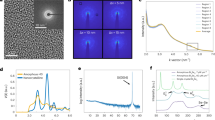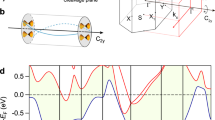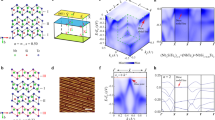Abstract
Topological insulators are a class of quantum materials in which time-reversal symmetry, relativistic effects and an inverted band structure result in the occurrence of electronic metallic states on the surfaces of insulating bulk crystals. These helical states exhibit a Dirac-like energy dispersion across the bulk bandgap, and they are topologically protected. Recent theoretical results have suggested the existence of topological crystalline insulators (TCIs), a class of topological insulators in which crystalline symmetry replaces the role of time-reversal symmetry in ensuring topological protection1,2. In this study we show that the narrow-gap semiconductor Pb1−xSnxSe is a TCI for x = 0.23. Temperature-dependent angle-resolved photoelectron spectroscopy demonstrates that the material undergoes a temperature-driven topological phase transition from a trivial insulator to a TCI. These experimental findings add a new class to the family of topological insulators, and we anticipate that they will lead to a considerable body of further research as well as detailed studies of topological phase transitions.
This is a preview of subscription content, access via your institution
Access options
Subscribe to this journal
Receive 12 print issues and online access
$259.00 per year
only $21.58 per issue
Buy this article
- Purchase on SpringerLink
- Instant access to full article PDF
Prices may be subject to local taxes which are calculated during checkout



Similar content being viewed by others
References
Fu, L. Topological crystalline insulators. Phys. Rev. Lett. 106, 106802 (2011).
Hsieh, T. H. et al. Topological crystalline insulators in the SnTe material class. Nature Commun. 3, 982 (2012).
Hasan, M. Z. & Kane, C. L. Colloquium: Topological insulators. Rev. Mod. Phys. 82, 3045–3067 (2010).
Qi, X-L. & Zhang, S-C. Topological insulators and superconductors. Rev. Mod. Phys. 83, 1057–1110 (2011).
Hsieh, D. et al. A topological Dirac insulator in a quantum spin Hall phase. Nature 452, 970–974 (2008).
Moore, J. E. The birth of topological insulators. Nature 464, 194–198 (2010).
Xu, S-Y. et al. Topological phase transition and texture inversion in a tunable topological insulator. Science 332, 560–564 (2011).
König, M. et al. Quantum spin Hall insulator state in HgTe quantum wells. Science 318, 766–770 (2007).
Fu, L. & Kane, C. L. Topological insulators with inversion symmetry. Phys. Rev. B 76, 045302 (2007).
Nimtz, G. & Schlicht, B. in Narrow Gap Semiconductors (ed. Höhler, G.) (Springer Tracts in Modern Physics, Vol. 98, Springer, 1983).
Khokhlov, D. R. (ed.) in Lead Chalcogenides: Physics and Applications (Taylor and Francis, 2003).
Pei, Y. et al. Convergence of electronic bands for high performance bulk thermoelectrics. Nature 47, 66–69 (2011).
Buczko, R. & Cywiński, Ł. PbTe/PbSnTe heterostructures as analogs of topological insulators. Phys. Rev. B 85, 205319 (2012).
Littlewood, P. B. et al. Band structure of SnTe studied by photoemission spectroscopy. Phys. Rev. Lett. 105, 086404 (2010).
Strauss, A. J. Inversion of conduction and valence bands in Pb1−xSnxSe alloys. Phys. Rev. 157, 608–611 (1967).
Dimmock, J. O., Melngailis, I. & Strauss, A. J. Band structure and laser action in PbxSn1−xTe. Phys. Rev. Lett. 16, 1193–1196 (1966).
Lent, C. S. et al. Relativistic empirical tight-binding theory of the energy bands of GeTe, SnTe, PbTe, PbSe, PbS, and their alloys. Superlatt. Microstruct. 2, 491–499 (1986).
Mitchell, D. L. & Wallis, R. F. Theoretical energy-band parameters for the lead salts. Phys. Rev. 151, 581–595 (1966).
Kriechbaum, M., Ambrosch, K. E., Fantner, E. J., Clemens, H. & Bauer, G. Electronic structure of PbTe/Pb1−xSnxTe superlattices. Phys. Rev. B 30, 3394–3405 (1984).
Dixon, J. R. & Hoff, G. F. Influence of band inversion upon the electrical properties of Pb0.77Sn0.23Se. Phys. Rev. B 3, 4299–4307 (1971).
Melngailis, J., Harman, T. C. & Kernan, W. C. Shubnikov-de Haas measurements in Pb1−xSnxSe. Phys. Rev. B 5, 2250–2257 (1972).
Qu, D-X., Hor, Y. S., Xiong, J., Cava, R. J. & Ong, N. P. Quantum oscillations and Hall anomaly of surface states in the topological insulator Bi2Te3 . Science 329, 821–824 (2010).
Taskin, A. A., Ren, Z., Sasaki, S., Segawa, K. & Ando, Y. Observation of Dirac holes and electrons in a topological insulator. Phys. Rev. Lett. 107, 016801 (2011).
Analytis, J. G. et al. Two-dimensional surface state in the quantum limit of a topological insulator. Nature Phys. 6, 960–964 (2010).
Ren, Z., Taskin, A. A., Sasaki, S., Segawa, K. & Ando, Y. Large bulk resistivity and surface quantum oscillations in the topological insulator Bi2Te2Se. Phys. Rev. B 82, 241306 (2010).
Szczerbakow, A. & Durose, K. Self-selecting vapour growth of bulk crystals—principles and applicability. Prog. Cryst. Growth Charact. Mater. 51, 81–108 (2005).
Szczerbakow, A. & Berger, H. Investigation of the composition of vapour-grown Pb1−xSnxSe crystals (x≤0.4) by means of lattice parameter measurements. J. Cryst. Growth 139, 172–178 (1994).
Berntsen, M. H., Götberg, O. & Tjernberg, O. An experimental setup for high resolution 10.5 eV laser-based angle-resolved photoelectron spectroscopy using a time-of-flight electron analyzer. Rev. Sci. Instrum. 82, 095113 (2011).
Jensen, B. N., Butorin, S. M., Kaurila, T., Nyholm, R. & Johansson, L. I. Design and performance of a spherical grating monochromator used at MAX I. Nucl. Instr. Meth. Phys. Res. A 394, 243–250 (1997).
Acknowledgements
We would like to acknowledge V. Domukhovski and A. Reszka for structural and chemical composition analyses of the crystals, J. Adell for his help during our beam time at MAX-lab, S. Safai for her help in numerical calculations, and P. Kacman for critical reading of the manuscript. In Poland, this work was supported by the European Commission Network SemiSpinNet (PITN-GA-2008-215368) and by the European Regional Development Fund through the Innovative Economy grant (POIG.01.01.02-00-108/09). In Sweden, this work was made possible through support from the Knut and Alice Wallenberg Foundation and the Swedish Research Council.
Author information
Authors and Affiliations
Contributions
P.D., B.J.K. and T.B. planned and performed the ARPES studies at MAX-lab and analysed the data. K.D. and M.S. did magnetotransport measurements. K.D. performed conductivity tensor analysis and wrote part of the manuscript. R.B. carried out theoretical band structure calculations. A.S. grew the crystals. E.Ł. characterized the crystals with the atomic force microscopy method. B.M.W., M.H.B., T.B. and O.T. performed the BALTAZAR ARPES measurements. B.M.W., M.H.B. and O.T. performed ARPES data analysis and wrote part of the manuscript. T.S. initiated the project and wrote part of the manuscript. All authors contributed to data analysis and editing of the manuscript.
Corresponding authors
Ethics declarations
Competing interests
The authors declare no competing financial interests.
Supplementary information
Supplementary Information
Supplementary Information (PDF 968 kb)
Rights and permissions
About this article
Cite this article
Dziawa, P., Kowalski, B., Dybko, K. et al. Topological crystalline insulator states in Pb1−xSnxSe. Nature Mater 11, 1023–1027 (2012). https://doi.org/10.1038/nmat3449
Received:
Accepted:
Published:
Issue Date:
DOI: https://doi.org/10.1038/nmat3449
This article is cited by
-
Axially lattice-matched wurtzite/rock-salt GaAs/Pb1−xSnxTe nanowires
Scientific Reports (2024)
-
Controllable strain-driven topological phase transition and dominant surface-state transport in HfTe5
Nature Communications (2024)
-
Acoustic realization of projective mirror Chern insulators
Communications Physics (2023)
-
Projected topological branes
Communications Physics (2022)
-
Angle-resolved photoemission spectroscopy
Nature Reviews Methods Primers (2022)



